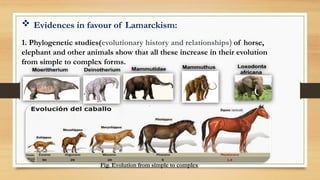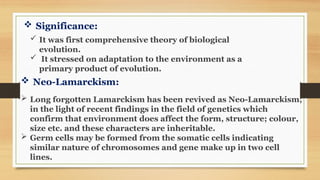Lamarckism is one of the earliest theories of evolution, proposed before Darwin. It explains how organisms change over time and adapt to their environment.
- 1. Sub-topic:-Lamarckism Topic:-Evolution By Laxman Khatal BO11732:Cell Biology & Evolution M.Sc
- 2. Why? Why we study Evolution?
- 3. We study evolution for the same reasons that we study any subject — the thirst for knowledge, to understand the past and predict the future, and to organize our world. But the subject of evolution also has huge relevance to our world and current issues that concern all of us. Evolution is not just about fossils. It is also about molecules, genes, mutations, populations, and sex in living organisms. All of these things are primary sources of data about evolutionary processes that occur when organisms try to survive and reproduce. Evolution also is about rigorous analyses — what we must do with the data to say something that is scientifically defendable.
- 4. WHAT IS EVOLUTION? “Evolution is a process of gradual change that takes place over many generations, during which species of animals, plants, or insects slowly change some of their physical characteristics.”
- 5. MAIN THEORIES OF EVOLUTION : Lamarckism or Theory of Inheritance of Acquired character Darwinism or Theory of Natural Selection. Mutation theory of De Vries. Neo-Darwinism or Modern concept or Synthetic theory of evolution.
- 6. INTRODUCTION Lamarck First theory of evolution was proposed by Jean Baptist de Lamarck(1744-1829) . French biologist who is best known for his idea that ‘acquired characters are inheritable, an idea known as Lamarckism, which is controverted by modern genetics and evolutionary theory. He explained it in his famous book Philosophiezoologique ("Zoological Philosophy, or Exposition with Regard to the Natural History of Animals") Fig. Lamarck’s Book
- 7. BASIC IDEA OF LAMARCKISM:
- 8. Lamarck’s Theory: Lamarck’s theory includes four main postulates: 1. New needs: 2. Use and disuse of organs: 3. Inheritance of acquired characters: 4. Speciation:Formation of new species
- 9. 1. New needs: Every living organism is found in some kind of environment. The changes in the environmental factors like light, temperature, medium, food, air etc. or migration of animal lead to the origin of new needs in the living organisms, especially animals. To fulfill these new needs, the living organisms have to exert special efforts like the changes in habits or behaviour. Fig. Migrate animals due to environmental condition.
- 10. 2. Use and disuse of organs: The new habits involve the greater use of certain organs to meet new needs, and the disuse or lesser use of certain other organs which are of no use in new conditions. This use and disuse of organs greatly affect the form, structure and functioning of the organs. Example:
- 11. Continuous and extra use of organs make them more efficient while the continued disuse of some other organs lead to their degeneration and ultimate disappearance. So, Lamarckism is also called “Theory of use and disuse of organs.” So the organism acquires certain new characters due to direct or indirect environmental effects during its own life span and are called Acquired or adaptive characters. Vestigial organs in human body Modification of foot in Aquatic birds Wing size reduce in kiwi birds (Flightless)
- 12. 3. Inheritance of acquired characters: Lamarck believed that acquired characters are inheritable and are transmitted to the offspring so that these are born fit to face the changed environmental conditions and the chances of their survival are increased. It is also commonly referred to as the theory of adaptation . Fig. Inheritance of acquired characters in offspring.
- 13. 4. Speciation:Formation of new species: Lamarck believed that in every generation, new characters are acquired and transmitted to next generation, so that new characters accumulate generation after generation. After a number of generations, a new species is formed. Fig. Formation of new species.
- 14. Evidences in favour of Lamarckism: 1. Phylogenetic studies(evolutionary history and relationships) of horse, elephant and other animals show that all these increase in their evolution from simple to complex forms. Fig. Evolution from simple to complex
- 15. 2. Giraffe: Development of present day long-necked and long fore-necked giraffe from deer-like ancestor by the gradual elongation of neck and forelimbs in response to deficiency of food on the barren ground in dry deserts of Africa. These body parts were elongated so as to eat the leaves on the tree branches. This is an example of effect of extra use and elongation of certain organs.
- 16. 3. Snakes: Development of present day limbless snakes with long slender body from the limbed ancestors due to continued disuse of limbs and stretching of their body to suit their creeping mode of locomotion and fossorial mode of living out of fear of larger and more powerful mammals. It is an example of disuse and degeneration of certain organs. Others evidences: Aquatic birds feet, Flightless birds reduce wings size, Horse increase in length of legs and decrease in functional digits for fast running over hard ground etc.
- 17. Due to the evidence against the theory, Lamarck's theories were subjected to criticism. Some of them are as follows: Lamarck stated that all the acquired characters are of use to the organism. Hence, they are inherited to their next generations. But this was not accepted as all the acquired characters need not be inherited to the next generation. Example: The boring of the pinna of the ear which is not carried to their next generations. The use and disuse theory has also been criticized due to several observations. Continuous usage of the eyes or heart did not result in an increase in size. Criticism of Lamarckism:
- 18. Weismann's germplasm theory criticized Lamarckism that the characters corresponding to somatic cells cannot be inherited, and only the characters which correspond to the germ cells can be inherited. He provided experimental proof for this theory in which Weismann cut off the tails of rats for 22 generations and allowed them to breed. But their offsprings were again tailed because the cells responsible for the growth of the tail are somatic and are not germ cells. Fig. Weismann’s mice tail experiment
- 19. Significance: It was first comprehensive theory of biological evolution. It stressed on adaptation to the environment as a primary product of evolution. Neo-Lamarckism: Long forgotten Lamarckism has been revived as Neo-Lamarckism, in the light of recent findings in the field of genetics which confirm that environment does affect the form, structure; colour, size etc. and these characters are inheritable. Germ cells may be formed from the somatic cells indicating similar nature of chromosomes and gene make up in two cell lines.
- 20. Lamarckism Neo-Lamarckism It is the original theory given by Lamarck. It is a modification of the original theory of Lamarck in order to make it more suitable to modern knowledge. The theory lays stress on internal vital force, appetency and use/disuse of organs. Neo-Lamarckism does not give any importance to these factors. It believes that change in environment brings about a conscious reaction in animals. The theory stresses on the direct effect of changed environment on the organisms. According to Lamarckism the acquired characters are passed onto the next generation. Only those modifications are transferred to the next generation which influence germ cells or where somatic cells give rise to germ cells. Difference between Lamarckism and Neo-Lamarckism:
- 21. The comparison, makes it clear that the point of agreement between the two theories is the importance of the effect of the environment on the organism to bring about evolution. however, even in this they differ in the mechanism. Neo-Lamarckist accepted that only those changes that occurred in the germplasm were inherited whereas Lamarckism made no distinction between somatoplasm and germplasm in this regard. CONCLUSION:
- 22. …






















